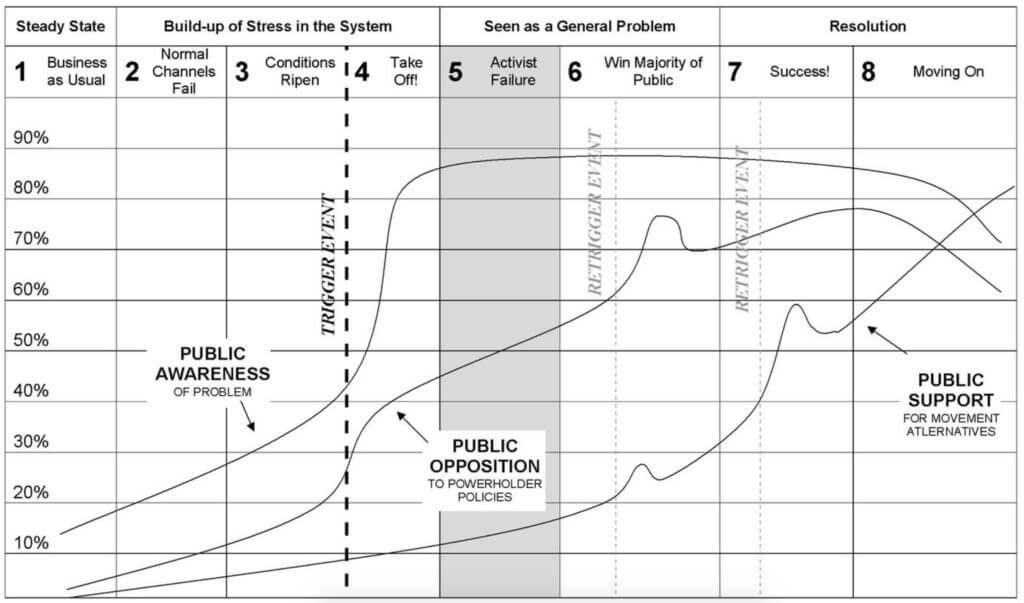Workplace age equity is not a buzzword–it’s for real, and it’s here to stay. In fact, it’s the only way organizations will recruit and retain diverse talent to drive their businesses. How can I be so sure? Because I already see evidence of it.
Companies are moving away from a youth-focused employee culture. In part, due to the realization that younger talent is becoming more scarce as people live longer and the birth rate continues its decline. But also because companies realize the workplace needs to reflect the full spectrum of their customer base, not just part of it.
Companies may say they are inclusive, but if they are not “age aware,” they are excluding a key protected group. Focusing on one issue is not enough. That’s why company leaders are asking about age inclusion. They recognize that, like #BLM and #MeToo, #AgeEquity will not go away until change has taken hold.
The Arch of Change
In the Age Equity Alliance training module on Social Innovation and Age Equity: Why Business & Society Need Both, I talk about the late social change activist Bill Moyer who, along with Martin Luther King, Jr., James Bevel, and Al Raby, led the Chicago Freedom Movement. The movement made specific demands to the City of Chicago, including fairness in housing, education, employment, education, and health.
Moyer’s experience in social activism and change led him to publish The Movement Action Plan: A Strategic Framework Describing The Eight Stages of Successful Social Movements in 1987. The Movement Action Plan was to support others involved in social change initiatives and encourage their longterm efforts. The plan outlines how culture change follows a formula and requires acceptance of ebb and flow when pushing for social change.

You’ll see that change begins between stages 3 and 4 with what Bill Moyer refers to as a triggering event. When it comes to workplace age equity, there are a few obvious “triggers.”
Working Past Age 65
Consider that 10,000 people have been turning 65 every day since 2011. This demographic shift will continue until 2030. These 65+ individuals are living longer, working longer, and demanding workplace equity the same as any other group.
Declining Birthrate
At the same time that 10,000 folks continue to turn 65 every day, the birth rate is declining. While many predicted another baby boom with COVID, the opposite actually occurred with birth rates dropping around the world in 2020. In the US, the birthrate dropped 7%. Falling fertility rates mean nearly every country could have shrinking populations by the end of the century. Twenty-three nations, including Spain and Japan, expect to see their populations halved by 2100.
Impact of COVID-19
COVID was another triggering event, given that it brought increasing awareness to age bias. Not only in terms of deciding who received life-saving care but also due to disproportionate job loss.
Props to Employee Resource Groups
When it comes to workplace equity issues, companies typically defer to HR or Diversity, Equity, and Inclusion practitioners. While they have been slow to incorporate “age equity” into DEI strategic programming, it is finally hitting the radar.
One of the biggest influencers for age inclusion in DEI planning is age-related employee resource groups (ERGs). Whether multigenerational or focused on early or late-career, age-related ERGs are raising the flag and helping their companies move the needle. Age-related ERGs also benefit from easy collaborations with other ERGs since, obviously, age impacts everyone across all dimensions of diversity.
I’m very proud of EveryGen, AEA’s ERG partnership program. Crafted to assist leaders of age-related ERGs at every stage–from start up to measuring success–EveryGen makes it easier for ERG leaders to create the impact (and change) they want to see.
It takes deliberate intention to carefully develop and cultivate a workplace with an environment that is equitable to all. Otherwise, the employee culture evolves spontaneously, and embedded in that evolution are biases, myths, and stereotypes that prevail in the workplace and across society.
Learn More
ERG leaders have day jobs, too, and EveryGen makes it easier to do both. If you are interested in starting an age-related ERG or would like strategic and tactical support, contact AEA for a free consultation.


Leave a Reply